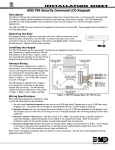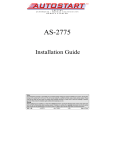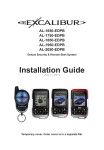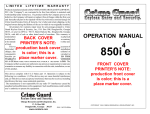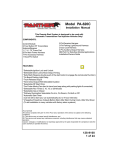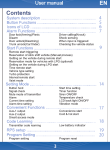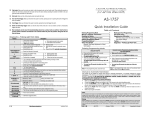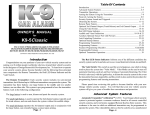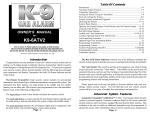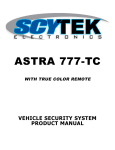Download Excalibur AL-1950-EDPB Installation manual
Transcript
AL-1950-EDPB / AL-2050-EDPB OLED Color 2-way Alarm & Remote Start July 12, 2012 Operation Guide Temporary cover. Color cover is in a separate file. Introduction Congratulations for choosing one of the most versatile, fully-featured vehicle security and convenience systems available today. Omega Research & Development has been a leader in vehicle security products for nearly 4 decades. Please take the time to read this manual thoroughly so you can fully enjoy the benefits and features this system offers. In this manual, you will primarily learn about 5 user interface components and how they work together in alerting you to system changes as well as how you can control system operations. Keep in mind that the operations described in this manual are written to only reflect the default system settings. Be sure to discuss any customization with your installer so you can remember any variations from this guide. Controllers: The system has a 2-way controller that, in addition to controlling the system, it will give you confirmations on system operations as well as violation alerts. A 1-way transmitter is also included. It is a standard remote control that still gives you control over all features but without confirmations. The next section covers the controllers’ operations in detail. The Status Lights: These lights are built into the system’s window-mounted antenna. They give you a visual indication of the system’s current state and provide troubleshooting indicators. The operations of the status lights are covered later in this manual. The Valet Switch: This push button gives you access to system programming, transmitter/controller programming, and valet functions. It is also built into the system’s window-mounted antenna. The valet switch’s operations are also covered later in this manual. Flashing Lights: The system is connected to your vehicle’s parking lights to provide a 360 degree visual confirmation, warning, & deterrence in almost all system operations. Each operation described in this manual also includes the corresponding indicator from the flashing lights. The flashing lights primarily provide visual deterrence when the system is violated. Siren and/or Horn Sounding: The system includes an electronic siren that offers confirmation chirps during daily operations and programming. It is also the primary means of alerting anyone near your vehicle that the system has been violated. The system is capable of sounding the vehicle’s horn in addition to, or in place of, the electronic siren. Most system functions have a corresponding audible alert that is described throughout this manual. Becoming familiar with these alerts will help you to instantly understand any changes in the system’s status. Controller & Transmitter Overview The 2-Way Controller AL-1950-EDPB Controller part number: 155-03 AL-2050-EDPB Controller part number: 156-03 1 1) Antenna: Sends commands to the system and receives confirmations for 2-way functions. 2) OLED Display: Displays all controller functions as well as the status of your system. 2 3) Backlit Buttons: Flashes while transmitting and indicates battery charging status. 4) Control Buttons: These are the primary use buttons LOCK, UNLOCK, TRUNK, & START. They are also used to navigate the controller’s options. 5) Charger Port: This is where you plug in the charger to recharge the controller’s battery. 6) Programming Button: This is used for setting controller features and many other functions. See “programming controller options” later in this manual. 3 4 4 5 6 The Controller Status Screen Vibration Mode Indicator Melody Indicator Alarm Clock ON icon Clock/Timer Battery Level Indicator* Current System State Vehicle Name (Programmable) Vehicle Image (Selectable) 2-way In Range Indicator Lock/Unlock Indicator *The controller is powered by a built-in rechargeable battery. When the battery level indicator shows a low battery, plug the supplied USB cable into the controller, then connect the other end to the supplied AC adapter, car adapter(AL-2050-EDPB only), or your computer’s USB port. While charging, the indicator will flash from empty to full and the backlit buttons will flash once every 5 seconds while charging. When full, the indicator will be solid green and the backlit buttons will stay illuminated. Controller & Transmitter Overview (cont’d) NOTE: The 2-way Controller is shipped from the factory in POWER OFF mode. If you connect the charger before powering it, perform POWER OFF, then POWER ON again. POWER ON: Press and hold the “P” button for at least 1 second POWER OFF: Press the “P” and “ “ buttons for at least 1 second The 1-Way Transmitter * AL-1950-EDPB part number: 148-03 AL-2050-EDPB part number: 1410-03 Call your dealer or visit www.caralarm.com to order replacement transmitters. Transmitter battery replacement: Remove the small screw from the lower back case, and separate the transmitter halves. Replace the battery(ies) and reassemble the transmitter case. Battery Types: 148-03 - CR2016 (2 required) 1410-03 - CR3032 (1 required) “lock” button “unlock” button “trunk” button “start” button 1410-03 Pictured Controller & Transmitter Functions LOCK / ARM: Press and release the “LOCK” button. • The Siren will chirp & the parking lights will flash once. • UPON RECEIVING CONFIRMATION FROM YOUR SYSTEM, the controller WILL PLAY the lock/arm animation and Beep once NOTE: Pressing lock twice in 5 seconds starts the parking timer. The clock will change to 0:00 and start counting in minutes & hours. (1-way transmitter: press the lock button) UNLOCK / DISARM: Press and release the “UNLOCK” button. • the siren will chirp twice & the parking lights will flash twice then illuminate for 30 seconds. • UPON RECEIVING CONFIRMATION FROM YOUR SYSTEM, the controller WILL PLAY the unlock/ disarm animation and beep twice. (1-way transmitter: press the Unlock button) Controller & Transmitter Functions (cont’d) TRUNK RELEASE / CHANNEL 2: Press the “TRUNK” button for 3 seconds. • The system will disarm and the trunk will open (if equipped). • UPON RECEIVING CONFIRMATION FROM YOUR SYSTEM, the controller WILL PLAY the TRUNK RELEASE animation and beep twice (1-way transmitter: press AND hold the trunk button for 3 seconds) * REMOTE START: Press and release the “ ” button twice within 5 seconds. (see user feature #17 for additional options) x2 • the parking lights will flash once and the status light will flash rapid green. • the system will turn on the ignitions and proceed to start the engine. • Once the engine is running, the parking lights will flash and the status lights will flash slow green. • UPON RECEIVING CONFIRMATION FROM YOUR SYSTEM, The controller WILL PLAY the REMOTE START animation and PLAY A MELODY. • The clock will change to 0:00 to start the remote start timer. it will time how long the engine runs in minutes & hours. (1-way transmitter: press the start button twice in 5 seconds) • If the engine stalls, the system will make up to 3 more attempts. • Each time you park your vehicle, set the climate controls to give you the desired interior temperature when you use the remote start. The engine will run for the preset run time (see user feature #18). * • Run Time Extender: Press the “ ” button one time while in remote start mode to restart the engine run timer. The timer on the controller will restart at “0:00”. NOTE: This can only be used once per remote start cycle. The controller will also give you “run time expiration” warning (2 chirps) 1 minute before the remote start cycle ends. • If you decide not to drive your vehicle, you can turn off the remote start using the same method to turn it on (Default = press “start” twice in 5 seconds) NOTE: If user feature #17 is programmed for 1 press, the 1st press = Run Time Extender so an additional press is required. • Upon entering the vehicle during remote start mode, turn the ignition key to the “ON/RUN” position (NOT START!!). When you press the brake pedal, the remote start will turn off allowing the ignition key to take over. Controller & Transmitter Functions (cont’d) * CHANNEL 3: Press and hold the “TRUNK” & “ “ buttons for 3 seconds. • YOUR SYSTEM will activate the channel 3 output. • UPON RECEIVING CONFIRMATION FROM YOUR SYSTEM, the controller WILL PLAY the CHANNEL 3 animation. (1-way transmitter: press AND hold the trunk & START buttons for 3 seconds) CHANNEL 4: Press and hold the “LOCK” & “TRUNK” buttons for 3 seconds. • YOUR SYSTEM Will activate the channel 4 output. • There is no 2-way confirmation for this function. (1-way transmitter: press and hold the lock & trunk buttons for 3 seconds) * CHANNEL 5: Press and hold the “UNLOCK” & “ “ buttons for 3 seconds • YOUR SYSTEM Will activate the channel 5 output. • There is no 2-way confirmation for this function. (1-way transmitter: press and hold the Unlock & START buttons for 3 seconds) * REMOTE VALET: Press and release the “ ” button within 5 seconds of unlocking/disarming the alarm system. • the system will enter alarm valet mode. see page 11 for more info on valet modeS. 1 2 (1-way transmitter: press and release the “START” button within 5 seconds of disarming the system) Controller & Transmitter Functions (cont’d) PANIC: Press and hold the “LOCK” or “UNLOCK” button for 3 seconds. • The siren/horn will sound, the parking lights will flash, and the doors will lock or unlock depending which button is pressed. (1-way transmitter: press AND hold the lock or unlock button for 3 seconds) OR SILENT ARM / DISARM: Press and release the “TRUNK” button twice in 5 seconds. • the parking lights will flash, and the doors will lock/ARM or unlock/Disarm depending on the current system status. • UPON RECEIVING CONFIRMATION FROM YOUR SYSTEM, the controller WILL PLAY the lock/ arm or unlock/disarm animation. (1-way transmitter: press release the “trunk” button twice in 5 seconds) x2 SENSOR BYPASS: Press and release the “TRUNK” button within 5 seconds of locking/arming the alarm system. • the system will give one chirp to indicate the sensor is bypassed. • UPON RECEIVING CONFIRMATION FROM YOUR SYSTEM, the controller WILL play the sensor bypass animation and Chirp once. (1-way transmitter: press and release the “trunk” button within 5 seconds of arming the system) 1 2 * LOW VOLTAGE/TEMP AUTO START: Press and release the “ ” button within 5 seconds of locking/arming the system. • the system will give one chirp to indicate the LOW VOLT/LOW TEMP(15 Degree ONLY) Autostart is activated. See page 9 for more info. • UPON RECEIVING CONFIRMATION, the controller will chirp once and the status will read “RS AUTO” every 5 seconds. 1 2 (1-way transmitter: press and release the “START” button within 5 seconds of arming the system) Controller & Transmitter Functions (cont’d) AUXILIARY FUNCTIONS 1-4: The actual operation of these functions will vary from car to car. They are designed to operate extra vehicle functions like automatic sliding doors or motorized hatches. Aux 1-4 are virtual outputs only available on certain vehicles when this system is integrated with the vehicle’s data network. Consult your installer to find out if any of these functions are available for your vehicle. If so, confirm each operation with the controller and write each function in the blank spaces provided below. - Auxiliary 1 Function (___________________): To activate this function, press and release the “trunk” and “start” buttons simultaneously). - Auxiliary 2 Function (___________________): To activate this function, press and release the “lock” and “trunk” buttons simultaneously). - Auxiliary 3 Function (___________________): To activate this function, press and release the “unlock” and “start” buttons simultaneously). - Auxiliary 4 Function (___________________): To activate this function, press and release the “unlock” and “trunk” buttons simultaneously). Other Remote Start Features Low Battery/Low Temp Automatic Starting This feature will automatically start the engine if the vehicle battery drops below 11 volts or the interior temperature drop to 15 (or 32) degrees fahrenheit. You must activate these features each time you park your car to use them. They can be activated one of two ways: Method 1 - Valet Switch • Turn the ignition switch “on”, then “off” (engine not running), and within 7 seconds press the valet switch twice. If there is a 2 second delay without additional valet button presses, the horn will honk 3 times activating low voltage start mode. • To activate low temp starting, enter low voltage start mode as described above but, before the horn honks, press the valet switch 1 time (15 degrees) or 2 times (32 degrees) within 5 seconds. The horn will honk to confirm your selection. Method 2 - With The Controller (Low Volt + Low Temp - 15 Degrees Only) • Within 5 seconds of pressing LOCK, press the START button. You will get one chirp and the 2-way controller will alternate between “ARM” and “RS AUTO”. NOTE: When low temp start mode is activated, low voltage start is also activated. These features will operate once every two hours until the ignition key is turned “ON”. Turbo Timer Feature It is typically recommended that vehicles equipped with turbocharged engines allow the engine to idle for after driving to cool the turbocharger. When this Installer Programmable Feature (#4) is enabled, the system will automatically keep the engine running as follows: • With the engine running, hold the brake pedal and engage the parking brake. When the brake pedal is released, the system will keep the engine running for the programmed time (1, 2, or 3 minutes), and then automatically turn it off. • The system may be locked while the engine is running. Turbo Timer can be prevented from engaging, or “bypassed” if desired, by turning the engine off before engaging the parking brake, or if it’s already engaged, step on the brake pedal to turn the engine off. Other Remote Start Features (cont’d) Pit-Stop Feature This feature allows you to leave your engine running for making quick errands. To use this feature, have the engine running normally from the ignition switch and your foot off the brake pedal. Press the Valet Switch twice; the parking lights will flash and the horn chirps 5 times. Turn the key off and the engine will remain running for the programmed run time. Manual Transmission Starting Remote starting with a manual transmission requires a different installation method and installer feature #5 must be turned on. Also, a setup procedure that ensures the transmission was left in neutral must be performed each time you leave your vehicle and intend to use remote start later. Perform these steps: 1) With the engine running, hold the brake pedal, apply the parking brake, then release the brake pedal. 2) Use the transmitter as if you were activating remote start (default: press START twice). The green status light will start to flash slow. 3) Turn off the ignition key and exit the vehicle. 4) Press LOCK on the transmitter. The engine will shut down (unless turbo timer is on) and the status light will flash green every 2 seconds to indicate it is ready to be remote started. NOTE: Manual transmission starting is canceled if you enter the vehicle after performing the setup procedure. Security System Features Last Door Arming This system can be configured to arm automatically when all the vehicle’s doors are closed (see user feature #2). When this feature is utilized, the siren/horn will chirp once when all of the doors are closed. At that point, it will start a 30 second countdown (indicated by a fast flashing status light). After 30 seconds, the system will arm (and lock the doors if configured to do so). During the 30 second arming delay, if a point of entry is opened, the countdown will pause until all entry points are closed again. Turning ON the ignition key will cancel the last door arming sequence until the key is turned off and the doors are all closed once again. Automatic Rearming This automatically rearms the alarm if the system is disarmed from the remote. (see user feature #3 to enable). When disarmed by remote, the system will start a 90 second countdown (fast flashing status light) to arm the system. This is useful if the controller may accidentally disarms the system when it’s kept in a purse or pocket where other items could potentially press the buttons. ENHANCED AUTO REARM allows you to cancel the countdown by pressing UNLOCK a second time within 5 seconds of the first press to disarm the alarm. Pre-Warn Detection This system’s impact sensor is designed, in addition to detecting a full impact, will warn away potential violators when it detects a light impact to the vehicle. The system will respond by chirping the siren/horn 3 times and locking the doors. This is very useful when an intruder attempts to unlock the door with “slim jim” types of devices Security System Features (cont’d) When The System Triggers If the system were to be compromised while armed, it will trigger sounding the siren/horn and flashing the parking lights for 30 seconds (programmable). At this point you will also be notified on the controller as to which zone is violated (if in range of the system). When disarming the system after a trigger event, the siren/horn will chirp 4 times and the parking lights will flash 4 times instead of the standard 2 times. LOCK ON TRIGGER: If a door is opened when the system is triggered, it will wait until the door is closed again, then lock the doors. This patented feature is useful to further deny a thief of further access to the vehicle. STORM SAFE MODE: When the system is triggered, pressing the “UNLOCK” button will stop the alarm from sounding but will leave the doors locked. This function is useful if you have a false triggering situation due to violent weather. ZONE VIOLATION RECALL: The system is capable of telling you which zones were triggered last. In addition to the controller’s trigger history log (discussed later in this manual), the system’s status light will flash to indicate which zone was triggered. This occurs during the alarm cycle AND after disarming. The system will store the last triggered zone until the vehicle’s ignition key is turned on. See “The Status Light” section of this manual for further explanation of this feature. NUISANCE PREVENTION: If the system prewarns 5 times within 15 minutes, it will bypass the zone for the remainder of the 15 minutes before rearming the pre-warn zone. Additionally, if a full trigger zone is left open, the system will trigger a total of 3 times before bypassing the zone. Once the zone is closed again, it will re-arm that zone. Using The Valet Switch Emergency Override If you were to lose your controller or if the battery were to die while the system is armed, you’d need to perform an emergency override to disarm the system and use your vehicle. To perform an emergency override, use the following steps: STEP 1 - Enter the vehicle (the alarm should trigger) STEP 2 - Turn the ignition key to the “ON” position STEP 3 - Press the valet switch (located in the window-mount antenna) once NOTE: Enter your SecureCode at this time if programmed via user feature #1 STEP 4 - Turn the ignition “OFF”. You can now use the vehicle as normal. It is advised to place the system in valet mode until you have a functioning controller once again. Valet Modes ALARM VALET MODE, while active, completely disables all security functions. Keyless entry and remote start are still operable. To enter valet mode, perform the following steps: STEP 1 - Disarm the system either with the controller or by performing an emergency override (make sure not to hold the brake pedal). STEP 2 - Press and hold the valet switch (located in the window-mount antenna) for 2 seconds. The system will chirp once and the RED status light will turn on. The controller will reflect on the status page that the system is in alarm valet mode. Using The Valet Switch (cont’d) REMOTE START VALET MODE, while active, disables remote start. Keyless entry and alarm functions are still operable. To enter remote start valet mode, perform the following steps: STEP 1 - Disarm the system either with the controller or by performing an emergency override and hold the brake pedal. STEP 2 - Press and hold the valet switch (located in the window-mount antenna) for 2 seconds. The system will chirp once and the GREEN status light will turn on. The controller will not reflect remote start valet mode. FULL VALET MODE combines both alarm & remote start valet modes. To activated full valet mode, follow these steps: STEP 1 - Enter remote start valet. You will hear a chirp. STEP 2 - Release the brake pedal but continue holding the valet switch. After 2 seconds, you will hear a second chirp. STEP 3 - Immediately release the valet switch. The status light will alternate between RED and GREEN every second. EXITING VALET MODES is as simple as just pressing and releasing the valet switch once. The status light will turn off. This procedure is the same for all forms of valet mode. SecureCode SecureCode allows you to customize the number of valet presses required to perform an emergency override. This is an extra layer of security that prevents anyone from overriding the alarm even if they have a key to the vehicle. SecureCode has 2 stages with the first requiring 1-9 button valet presses and the second requiring 0-9 valet button presses. This gives you 99 possible combinations. To program a custom SecureCode, please refer to user feature #1. To perform an emergency override with SecureCode, use the following steps: STEP 1 - With the system armed, enter the vehicle (the alarm will trigger). STEP 2 - Turn the ignition switch to the “ON” position. STEP 3 - Within 5 seconds of step 2, press the valet switch to enter the first digit of your programmed code. STEP 4 - After a few seconds, the siren will stop sounding and chirp once (confirming stage 1). The siren will then continue sounding. STEP 5 - Now, within 5 seconds of step 4, press the valet switch to enter the second digit of your code. If the code is correct, the alarm will disarm. If the code is entered incorrectly, you must turn the ignition key OFF, then back ON to try again. Additionally, if 2 failed attempts are made, the alarm will ignore any further attempts for 2 minutes. The Status Light The status lights, located in the window-mount antenna, provide a visual indication of the system’s status via GREEN (remote start status) and RED (alarm status) lights. SECURITY SYSTEM STATUS (RED LIGHT): OFF: The alarm is disarmed and not performing any automatic functions. ON CONSTANT: The alarm is in valet mode. FLASHING SLOW: The alarm is armed and monitoring all entry points. FLASHING FAST: One of the automatic arming features is in progress. The Status Light (cont’d) AUTOMATIC TRANSMITTER VERIFICATION (RED LIGHT): Every time you turn on the ignition key, the status light will flash a number of times equal to the number of controllers/transmitters programmed to the system. This unique security feature protects you from a potential thief (valet attendant, mechanic, installer, etc.) from adding their own transmitter without your knowledge and accessing your vehicle and it’s contents at a later time (the perfect crime!). ZONE VIOLATION RECALL: If the security system is triggered, the RED status lights will flash a number of times to indicate exactly which zone(s), has been violated. It will store the last 2 violated zones and continually repeat the flash pattern until the system is disarmed and the vehicle’s ignition key is turned ON. 2 FLASHES: Hood trigger 3 FLASHES: Door trigger 4 FLASHES: Sensor port trigger REMOTE START STATUS (GREEN LIGHT): OFF: The remote start is off and in standby mode. ON CONSTANT: The remote start is in valet mode. FLASHING SLOW: The engine was started successfully and is running. FLASHING FAST: The remote start sequence has begun and is in process of starting the vehicle’s engine. REMOTE START DIAGNOSTICS (GREEN LIGHT): The remote start system can also indicate which zone caused the last remote start cycle was ended. To see this indicator, place the system into alarm valet mode. Immediately after the chirp, the GREEN status light will flash to indicate what caused remote start to end. 1 FLASH: Run time expired. 2 FLASHES: Brake pedal was pressed. 3 FLASHES: Engine stalled or a bad tach signal. 4 FLASHES: Received transmitter command to stop. 5 FLASHES: Gear selector was moved from park(or the parking brake was released). 6 FLASHES: The alarm was triggered or low battery voltage. COMBINATION INDICATIONS: This indication reflect combinations of functions involving the security system AND remote start. SLOWLY ALTERNATES GREEN/RED: System is in full valet mode. SOLID GREEN W/ RED FLASH: System is in remote start valet w/ the alarm armed. SOLID RED W/ GREEN FLASH: System is in alarm valet w/ remote start activated. FAST ALTERNATES GREEN/RED: Alarm armed w/ remote start activated. SLOW FLASHING GREEN W/ 1-4 RED FLASHES: Zone violation recall during remote start mode. SLOW FLASHING RED W/ 1 GREEN FLASH: System is armed and ready to remote start in manual transmission mode Multi-Car Operation & Vehicle Profiles Multi-car Operation The controller can operate up to 2 different systems. When controlling 2 systems, it will receive all status updates on the currently selected vehicle profile and will receive only trigger alerts for the 2nd vehicle. You can switch from one car to the other at anytime as well as choose a unique image and name for each vehicle. Use the following steps to change vehicle profiles as well as select the vehicle image and name. Programming The Vehicle Image & Name Programming Controls Scroll Up Return To Previous Screen Scroll Down Select Highlighted Option - Press for 3 seconds to access the options menu. - Press and release to return to the status screen. 1) Press the “P” button for 3 seconds to access options. 2) Scroll down until “Vehicle Info” is highlighted (pictured to the left above). 3) Press the 4 button to select. 4) Scroll to highlight Vehicle #1 or Vehicle #2 5) Press the 4 button to select. 6) The image option will be highlighted. Scroll up or down to change the image. (pictured to the left) 7) Press the 4 button to select. 8) The first letter of the name is highlighted. Use the up and down arrows to scroll through the alphabet/numbers. Press the 4 button to move to the next space. Press to move back a space. The name can be up to 8 characters. After selecting the 8th character, you will return to the Vehicle #1/#2 selection screen. Press the “P” button to return to status screen or press the button to return to the main menu. Selecting Vehicle #1 or Vehicle #2 Vehicle #1: Press the “P” and “LOCK” buttons for 1 second to select Vehicle #1. The controller will beep/vibrate once. Vehicle #2: Press the “P” and “UNLOCK” buttons for 1 second to select Vehicle #2. The controller will beep/vibrate twice. Programming Controller Options Each function button on the controller also serves for navigating through the option menus and making changes to the controller options. These secondary functions are indicated by small icons in the upper corners of each button. See below for an explanation of each button’s function. Programming Controls Return To Previous Screen Scroll Up Select Highlighted Option Scroll Down - Press for 3 seconds to access the options menu. - Press and release to return to the status screen. Button Lock This feature disables the function buttons from operating when pressed. This prevents accidental system activation. To activate: 1) Press the “P” button to access the options menu. 2) “Button Lock” will be highlighted by default. 3) Press the 4 button to select. All function buttons are now locked. 3) To unlock the buttons, press “ “ then “UNLOCK”. * Setting The Alarm Clock *To disable, perform steps 1-5 but select OFF on step 4 **The alarm clock has an optional 24 hour format (see “setting the clock”) 1) Press the “P” button to access the options menu. 2) Scroll down until “Alarm Clock” is highlighted 3) Press the 4 button to select. 4) Scroll down to highlight ON*. 5) Press the 4 button to select. 6) The hour will now be highlighted. Scroll to select the desired hour. 7) Press the 4 button to select. 6) The hour digits will now be highlighted. Scroll to select the desired hour. 8) Press the 4 button to select. 9) The minute digits will now be highlighted. Scroll to select the desired minute setting. 10) Press the 4 button to select. END HERE IF CLOCK IS IN 24 HOUR FORMAT 11) AM/PM will now be highlighted**. Scroll to select the desired setting. 12) Press the 4 button to select. Programming Controller Options (cont’d) Setting The Clock 1) Press the “P” button to access the options menu. 2) Scroll down until “Set Clock” is highlighted 3) Press the 4 button to select. 4) Scroll to highlight either 12 (AM/PM) or 24 hour format. 5) Press the 4 button to select. (the hour is highlighted) 6) Scroll to select the desired hour. 7) Press the 4 button to select. (the hour is highlighted) 6) The hour digits will now be highlighted. Scroll to select the desired hour. 8) Press the 4 button to select. 9) The minute digits will now be highlighted. Scroll to the desired minute setting. 10) Press the 4 button to select. END HERE IF CLOCK IS IN 24 HOUR FORMAT 11) AM/PM will now be highlighted. Scroll to select the desired setting. 12) Press the 4 button to select. Power Save Mode The 2-way portion of the controller can be disabled com pletely to save battery life while traveling or out of range of the vehicle. To set power save: 1) Press the “P” button to access the options menu. 2) Scroll down until “Power Save” is highlighted 3) Press the 4 button to select. 4) Scroll to select ON or OFF, whichever is desired. 3) Press the 4 button to select. When Power Save mode is ON, you will not receive any 2-way confirmations. Additionally, there will be a red X over the “in range” indicator in the lower left corner of the status screen (pictured to the left). Screen Lighting This option selects how long the screen will stay lit before turning back off. Keep in mind that longer settings sacrifice some battery life. To program: 1) Press the “P” button to access the options menu. 2) Scroll down until “Screen Lighting” is highlighted 3) Press the 4 button to select. 4) Scroll to select the desired time interval. 3) Press the 4 button to select. Programming Controller Options (cont’d) Selecting Button Beep With this option turned ON, the controller will beep to confirm each button press. The default setting is OFF. To turn ON/OFF, use the following procedure: 1) Press the “P” button for 3 seconds to access options. 2) Scroll down until “Button Beep” is highlighted 3) Press the 4 button to select. 4) Scroll up or down to highlight the desired setting. 5) Press the 4 button to select. Selecting Remote Start Melodies This option allows you to select from 5 different melodies to indicate when remote start is turned on and off. To change the setting, use the following procedure: 1) Press the “P” button for 3 seconds to access options. 2) Scroll down until “Melodies” is highlighted 3) Press the 4 button to select. 4) Scroll up or down to highlight the desired setting. 5) Press the 4 button to select. Demo Mode Demo mode will show you a demonstration movie of all the controller’s confirmation animations and alerts. To view demo mode, use the following steps. 1) Press the “P” button for 3 seconds to access options. 2) Scroll down until “DEMO” is highlighted 3) Press the 4 button to select. Selecting Melody & Vibrate modes Whenever 2-way alerts are received from the system, the controller can alert you with a melody, vibration, or both. By default, the controller is set for melody only. Press the “P” and trunk buttons simultaneously for 2 seconds to scroll through each setting. The sequence is VIBRATE only, MELODY & VIBRATE, MELODY only. The melody and vibrate icons at the top of the status screen will change to indicate your selection. Parking Timer & Remote Start Timer The controller has 2 convenient timer functions. The PARKING TIMER tells you how long you’ve been parked in case you are at a parking meter or other parking areas with time restrictions. The REMOTE START TIMER tells you how long your engine has been running in remote start mode. PARKING TIMER: Press LOCK twice within 5 seconds. When the controller receives both LOCK confirmations, it will start the timer. REMOTE START TIMER: This turns on every time you remote start. Note: Pressing the “P” during either timer mode will switch between the timer and clock. Anti-Carjacking Protection The system is equipped with two separate Anti-Carjacking protection features (ignition, open door, or both). All are programmable, and must be turned on to operate. Once activated, the user has 53 seconds to cancel the Anti-Carjacking protection process (described below). If Anti-Carjacking is not cancelled, 53 seconds after being activated the siren will begin to chirp for 7 seconds to alert the user that the system is about to enter into an alarm condition. The Valet Switch may still be pressed once during this period to cancel the Anti-Carjacking process. If the Anti-Carjacking process is not cancelled before the 60 second countdown expires, the system will enter an alarm condition, sounding the siren and flashing the parking lights. 30 seconds after this occurs, or should the ignition be turned off in the meantime, the stater interrupt will engage. Once the system enters the alarm condition, it will not respond to the transmitter, nor will the system reset automatically after 60 seconds, and it can only be disengaged by: Step 1 Turning the vehicle’s ignition off. Step 2 Turning the ignition back on. Step 3 Within 5 seconds, perform an Emergency Override using the Valet Switch. If the SecureCode has been customized, the correct number of Valet Switch presses must be made. The different types of Anti-Carjacking protection are: Ignition Activated Anti-Carjacking activates every time the vehicle’s ignition is turned on. The Valet Switch must be pressed within 60 seconds of activating to cancel Anti-Carjacking. This is User Programmable Feature #15. Door Anti-Carjacking activates when a door is opened after the vehicle is started and the engine is running. The Valet Switch must be pressed within 60 seconds after activation to cancel Anti-Carjacking. This is User Programmable Feature #15. Programming Controllers/Transmitters Standard Programming: Using this method to program additional or replacement transmitters does not turn on or otherwise affect the Unauthorized Transmitter Alert (UTA) feature. Before you begin, have all transmitters which are to operate the system at hand and make sure the correct vehicle profile (see page 14) is selected on the controller(s)*. Step 1Then, turn the ignition “on”. Step 2Within 5 seconds of Step 1, press the Valet Switch 5 times. The siren/horn will briefly sound, confirming that the system is ready to learn a transmitter code. Programming Controllers/Transmitters (cont’d) Step 3Press the “lock” button on each transmitter one at a time. The system will chirp the siren/horn once to confirm that each was learned. When programming the 2-way controller, the system’s ID is sent to the controller. Wait for the controller to beep twice, indicating it has learned the system’s ID*. If a code is not received within 10 seconds of Step 2, the learning process will automatically exit. * If you are changing which vehicle profile is programmed to your system (ie. it was originally programmed for car1 and you want it to be car2), you will need to erase the system ID from the controller before programming controllers/transmitters. To do so: Step 1 Press LOCK, UNLOCK, TRUNK, & START simultaneously for 1 second (if done correctly, the controller’s buttons will not illuminate). The controller will give a short beep/vibration. Release the buttons. Step 2 Press LOCK, UNLOCK, TRUNK, & START simultaneously for 1 second again. The controller will give a long beep/vibration. Release the buttons, the system ID is now erased. If the Unauthorized Transmitter Alert feature is on, programming a transmitter to the system will activate the “UTA” warning and the extended Status Light indication. For the next 48 hours, the siren/horn will sound a brief series of chirps every time the vehicle’s ignition key is turned on. Special Programming procedure to turn on the UTA feature: Using this method to program transmitters or optional controllers, and to turn on the Unauthorized Transmitter Alert feature. Follow the same steps as the Standard Programming, but on any transmitter/controller being programmed instead of pressing the “lock” button, press the “lock” and the “unlock” buttons together. This action turns on the Unauthorized Transmitter Alert feature and at the same time programs the transmitter or controller to operate the system. Once the Unauthorized Transmitter Alert feature is turned on, the warning will sound for 48 hours after any transmitter programming, including the programming session which was used to turn it on. This feature can only be turned off again by sending the system back to Omega for a reset. Programming Features Step 1 Turn the ignition key “ON”, then “OFF” Step 2 Within 5 seconds of step 1, press the valet switch 5 times to access user features (10 times to access installer features). ~ The siren/horn will sound and the status light will turn on. Step 3 Within 10 seconds of step 2, press the valet switch the number of times corresponding with the desired feature’s number. ~ The siren/horn will chirp, the status lights, and the parking lights will flash equal to the selected feature. Step 4 Change the feature by pressing the transmitter button that corresponds with the desired setting. The siren/horn will chirp to correspond with the chosen setting. User Programmable Features Feature #1 - SecureCode DEFAULT - 1 Press SecureCode is a unique patented feature which allows you to custom select the number of Valet Switch presses in two stages, instead of a single “1 press”, which would be required in order to perform an Emergency Override. If any of the three anti-carjacking features are utilized, a customized SecureCode would also be required to turn it off once it is fully activated. The SecureCode operation is described on page 12. To custom program a new SecureCode: Step 1Follow Steps 1 to 4 in the previous “Programming Features” section to access “feature #1”. Step 2Within 10 seconds slowly press and release the controller or transmitter’s “arm/lock” button the number of times equal to the desired SecureCode for stage 1, allow the system to respond to each controller/transmitter button press with a siren chirp before pressing the button again. A few seconds after the final button press, the system will chirp the horn/siren confirming the total number for stage 1. Step 3Configure stage 2 of the SecureCode by pressing and releasing the “disarm/ unlock” button the number of times desired for the stage 2. The system will confirm as it did for stage 1. Feature #2 - Last Door Arming Off (press “lock” button to program) - DEFAULT On w/o Doors Locking (press “unlock” button to program) On w/ Doors Locking (press “trunk” button to program) “Last Door Arming” has the system automatically arm itself every time you exit the vehicle (the complete operation is described on page 10). This feature turns that operation on or off, and with options of having Last Door Arming operate with or without also locking the doors when the system does arm. Feature #3 - Automatic Rearming Off (press “lock” button to program) - DEFAULT On w/o Doors Locking (press “unlock” button to program) On w/ Doors Locking (press “trunk” button to program) Enhanced Auto Rearm (press “start” button to program) “Automatic Rearming”, described on page 10, rearms the alarm if accidentally disarmed. Options are to have Automatic Rearming operate with or without also locking the doors when the system does rearm. Enhanced auto rearm allows you to cancel the rearming sequence by pressing unlock a 2nd time after disarming. Feature #4 - Starter Interrupt Functions Alarm Only (press “lock” button to program) - DEFAULT Anti-Grind Only (press “unlock” button to program) Alarm & Anti-Grind (press “trunk” button to program) Automatic (press “start” button to program) Alarm Only - The Starter Interrupt is operable whenever the alarm is armed. Anti-Grind Only - The Starter Interrupt is operable whenever remote start is on. Alarm & Anti-Grind - This setting engages starter interrupt when the alarm is armed AND when the system is in remote start mode. This prevents the starter from grinding if the user accidentally turns the key to “START” during remote start. Automatic - This will cause the Starter Interrupt output to automatically engage 90 seconds after the ignition switch is turned “off”, and after disarming. User Programmable Features (cont’d) Feature #5 - Ignition Activated Override Off (press “unlock” button to program) - DEFAULT On (press “lock” button to program) This feature allows an activated system to be overridden and disarmed by simply turning the ignition switch on within 10 seconds of the system’s activation. After 10 seconds, the Emergency Override must be performed. Feature #6 - Ignition Controlled Lock/Unlock Off (press “lock” button to program) - DEFAULT Lock w/ Ignition On (press “unlock” button to program) Unlock w/ Ignition Off (press “trunk” button to program) Lock And Unlock w/ Ignition (press “start” button to program) This feature controls the lock/unlock operations when the ignition key is turned on/off, Feature #7 - Open Door Bypass of Ignition Locking On (press “arm/lock” button to program) - DEFAULT Off (press “disarm/unlock” button to program) This feature cancels the automatic locking or unlocking of the vehicle’s doors if one of the doors is open when the ignition switch is turned on or off. Feature #8 - Confirmation Chirps On (press “lock” button to program) - DEFAULT Except Valet Mode (press “unlock” button to program) On Demand (press “trunk” button to program) Off (press “start” button to program) This feature removes the system’s arming and disarming confirmation chirps for particular functions. The “On Demand” setting allows you to lock and unlock the doors without chirps. Similar to OEM keyless entry, pressing either function a 2nd time, will produce confirmation chirps. Feature #9 - Confirmation Chirp Volume Medium High (press “trunk” button to program) - DEFAULT Low (softest) (press “lock” button to program) Medium Low (press “unlock” button to program) High (loudest) (press “start” button to program) This feature allows the choice of four different volume levels of the system’s confirmation chirps, and when programming it, the buttons can be repeatedly and sequentially pressed, thus making it easy to hear and choose the setting with the best chirp volume. Feature #10 - Alarm Duration 30 Seconds (press “lock” button to program) - DEFAULT 60 Seconds (press “unlock” button to program) 90 Seconds (press “trunk” button to program) 120 Seconds (press “start” button to program) This feature allows four choices of the Alarm Duration, which is the period of time for which the system sounding the siren (and/or horn, optionally) and flashes the parking lights when it is triggered. Caution: Before lengthening the Alarm Duration you should always check and determine if there are any local anti-noise or nuisance ordinances in your area, to avoid the possibility of receiving a violation citation. User Programmable Features (cont’d) Feature #11 - Flashing Light Confirmations On w/ Disarm, Flash w/ RS (press “unlock” button to program) - DEFAULT On w/ Disarm & Remote Start (press “lock” button to program) On During Remote Start (press “trunk” button to program) Flashing During Remote Start (press “start” button to program) This feature affects the parking light confirmations for system disarm & remote start functions. With the above options, you can select any combination of: - Flashes twice after disarm - Flashes twice then stays on for 30 seconds after disarm - Stays on during remote start mode - Flashes slowly during remote start mode Feature #12 - 2nd Channel (Trunk Release) Also Disarms System On (press “lock” button to program) - DEFAULT Off (press “unlock” button to program) “2nd channel” is most commonly used for trunk release, in which case the alarm should also disarm. This feature, turned on, configures the system to disarm when the 2nd channel is used. Feature #13 - Arming Delay 3 Seconds (press “lock” button to program) - DEFAULT 15 Seconds (press “unlock” button to program) 30 Seconds (press “trunk” button to program) 45 Seconds (press “start” button to program) This determines how long the alarm waits to monitor trigger inputs after arming the system. Longer durations allow some vehicle systems to “settle” before monitoring to prevent false trigger conditions. Feature #14 - Alarm Functions Bypass Off (press “unlock” button to program) - DEFAULT On (press “lock” button to program) This feature converts the system into a strictly Keyless Entry/Remote Start System by eliminating all antitheft alarm-oriented operations and features. Feature #15 - Anti-Carjacking Off (press “start” button to program) - DEFAULT Ignition Only (press “lock” button to program) Door Only (press “unlock” button to program) Ignition + Door (press “trunk” button to program) This selects between the 2 forms of anti-carjacking protection. Details on using anticarjacking protection are described on page 18. Feature #16 - Open Door Warning Upon Arming Off (press “unlock” button to program) - DEFAULT On (press “lock” button to program) When this feature is turned on, if one of the vehicle’s doors is open at the time that the system is armed via the controller or transmitter, the siren will chirp 3 times and the parking lights will flash 3 times instead of once. User Programmable Features (cont’d) Feature #17 - Remote Start Activation Press “start” button 2 times (press “lock” button to program) - DEFAULT Press “start” button 1 time (press “unlock” button to program) Press Lock & Unlock (press “trunk” button to program) This feature changes how the remote start feature is activated using the controller or transmitter. Feature #18 - Remote Start Run Time 10 Minutes (press “disarm/unlock” button to program) - DEFAULT 5 Minutes (press “arm/lock” button to program) 15 Minutes (press “trunk” button to program) 20 Minutes (press “start” to program) This feature sets the period of time that the engine will run when remote started. If the engine is not stopped by controller/transmitter command or a safety circuit violation, the engine will automatically stop upon the expiration of the selected time period. Installer Programmable Features This group of Installer Programmable Features are all accessed as a group in the second level of features’ programming. These features have a direct affect upon the system’s operations related to the installation and vehicle type AND SHOULD ONLY BE CHANGED BY THE INSTALLER!!! Feature #1 - Doorlocking Functions 0.8 Second Outputs (press “lock” button to program) - DEFAULT 3 Second Outputs (press “unlock” button to program) Double Pulse Unlock Output (press “trunk” button to program) Total Closure Lock Output (press “start” button to program) This single feature gives the installer several needed options, to match the system’s doorlocking outputs to suite different vehicle requirements. The total closure setting provides a 28 second lock pulse and a 0.8 second unlock pulse. Feature #2 - Light Relay Functions Dome Light Output (press “lock” button to program) - DEFAULT Door Lock (press “unlock” button to program) Ignition Output (press “trunk” button to program) Accessory Output (press “start” button to program) The system has two built-in relays, which can be programmed to perform several different functions. The primary function of this relay, is to operate the vehicle’s dome, or interior lighting as part of the system’s operations. Optionally, if desired or needed, this relay can be programmed to be a door lock relay, or as medium-capacity ignition or accessory outputs (10A max), if needed for remote starting use. Installer Programmable Features (cont’d) Feature #3 - Horn Relay Functions Horn Output (press “lock” button to program) - DEFAULT Door Unlock (press “unlock” button to program) Trunk Release (press “trunk” button to program) Pulse After Start (press “start” button to program) The primary function of this second relay, is to operate the vehicle’s existing horn; either in conjunction with the electronic siren, or in place of the siren. Using both the siren and the horn creates an extremely effective security system. Optionally, if desired or needed, this relay can be programmed as a door unlock, trunk release, or pulse after start relay. Feature #4 - Turbo Timer Off (press “lock” button to program) - DEFAULT Run 1 Minute (press “unlock” button to program) Run 2 Minutes (press “trunk” button to program) Run 3 Minutes (press “start” button to program) This feature, the operation of which is described on page 9, when turned on configures the system to automatically keep the engine running briefly after it is turned off. This operation is designed specifically for vehicles having turbocharged engines (the user may temporarily bypass the feature if desired). This feature should only be programmed by the installer, and the operation of this feature depends on the correct connection of the safety wire to the vehicle’s parking brake. Feature #5 - Manual Transmission Mode Off (press “unlock” button to program) - DEFAULT On (press “lock” button to program) This feature changes the parameters of the system’s remote start operation to be suitable for manual transmission-equipped vehicles via a “setup” procedure which must be followed upon exiting the vehicle to ensure the transmission is in neutral. Feature #6 - Engine Detection Method (press “lock” button to program) - DEFAULT Tachless Hi Tachless Lo (press “unlock” button to program) Tach Wire (press “trunk” button to program) Data Tach (press “start” button to program) Crank Only (press “lock” & “unlock” to program) This feature selects the method in which the remote start monitors the engine’s running condition in remote start mode. “Tachless Hi” sensitivity mode uses a preset crank time (see installer feature #7) and monitors the vehicle’s voltage level to determine if the engine is running. This setting looks for a voltage increase of 0.3v after cranking. “Tachless Lo” sensitivity mode operates like the “Tachless Hi” setting but looks for a voltage increase of 0.5v after cranking. “Tach Wire” Before this setting is programmed, refer to the “Violet/White wire” section of the installation manual for proper wiring connection and the Tach Learn Procedure. It will crank the engine for up to 3 seconds or until a tach signal is detected. “Data Tach” mode operates just like the “Tach Wire” setting except it takes its reading from the D2D data port instead of using the Violet/White wire. Before using, make sure this function is supported by the Databus Interface module. “Crank Only” AKA “blind start” is similar to the “Tachless” settings however, it only makes one start attempt and does not monitor engine running conditions. This is useful for many “push-tostart” vehicles. Installer Programmable Features (cont’d) Feature #7 - Starter Cranking Time 0.75 Second (press “lock” button to program) - DEFAULT 1.00 Second (press “unlock” button to program) 1.5 Seconds (press “trunk” button to program) 2.25 Seconds (press “start” button to program) This feature determines the crank time of the 1st start attempt when in “Tachless” mode. If the engine doesn’t start on the first attempt, it will retry up to 3 more times extending the crank time by an additional 0.2 second with each attempt.. Feature #8 - PINK/WHITE (IGN #2)Wire Function Ignition (press “lock” button to program) - DEFAULT Accessory(press “unlock” button to program) Starter (press “trunk” button to program) This feature changes the operation of the unit’s large PINK/WHITE output wire. This feature should only be programmed by the installer. Feature #9 - Arm, Disarm or Additional Channels Arm / Disarm (press “lock” button to program) - DEFAULT Arm / Channel 5 (press “unlock” button to program) Channel 4 / Disarm (press “trunk” button to program) Channel 4 / Channel 5 (press “start” button to program) The system has outputs designed for arming and/or disarming a factory-equipped security system. These wires may be used instead to provide further system outputs, which are remotely operated by the controller or transmitter. These outputs are in addition to the 2nd channel and 3rd channel outputs.As shown in the programming assignment, the arm, disarm, channel 4 and channel 5 are programmable as various combinations. For example, if the disarm output is needed, but not the arm output, then channel 4 may be made available for use. Feature #10 Gasoline Or Diesel Engine Gasoline (press “lock” button to program) - DEFAULT Diesel 15 Sec. Delay (press “unlock” button to program) Diesel 20 Sec. Delay (press “trunk” button to program) Diesel 30 Sec. Delay (press “start” button to program) This feature changes the system’s timing of the ignition and starter output sequence for gas or diesel engines. Gasoline: the starter output will occur 3 seconds after the ignitions turn on. When in “Tachless” mode, the engine running status is determined 10 seconds after starting. Diesel: the starter output will occur 15, 20, or 30 seconds after the ignitions turn on (allows for glow plug warming). When in “Tachless” mode, the engine running status will be determined 40 seconds after cranking. Feature #11 Remote Start Lock Control Off (press “lock” button to program) - DEFAULT Lock After Start (press “unlock” button to program) Unlock before start (press “trunk” button to program) Unlock Before+Lock After Start (press “start” button to program) This feature allows for OEM alarm/lock control in relation to remote start operations thus eliminating extra wiring. Installer Programmable Features (cont’d) Feature #12 Low Temp Crank Extender 0ms (Off) (press “lock” button to program) 200ms (press “unlock” button to program) - DEFAULT 300ms (press “trunk” button to program) 400ms (press “start” button to program) When the vehicle’s interior temperature is below freezing, this feature adds extra crank time to the base timing (see installer feature #7). It applies to tachless modes only (installer feature #6) Feature #13 Data Port Protocol ADS (iData) (press “unlock” button to program) D2D (Trilogix) (press “lock” button to program) - DEFAULT This feature determines which data protocol is used on both data ports. Choose this based on the accessory being connected to the port. NOTE: When a BLADE is inserted, this feature automatically switches to the ADS protocol. Feature #14 Lock On Prewarn On (press “lock” button to program) - DEFAULT Off (press “unlock” button to program) By default, if the prewarn zone is triggered, the system will automatically lock the doors to combat unauthorized entry from lock picking. If this causes conflict with OEM vehicle functions, you can turn it off. Feature #15 Blue Satellite Port, Blue Wire Function Status (press “lock” button to program) - DEFAULT Pulse Before Start (press “unlock” button to program) Pulse After Start (press “trunk” button to program) Pulse After Engine Off (press “start” button to program) This determines the function of the Blue wire on the Blue satellite relay port. The Status setting turns on briefly before the Ignition output and stays on during remote start mode. The other settings give a 0.8 second pulse under the selected condition. Feature #16 Low Current / Motorcycle Mode On (press “lock” button to program) Off (press “unlock” button to program) - DEFAULT This feature, when on, reduces the system’s current draw by as much as 40% to maximize the vehicle’s battery life while the alarm is armed. It causes the starter interrupt output to only operate when the ignition is turned on and reduces the frequency of the “armed” flashing status light significantly. This is ideal when the system is to be used on vehicles that have limited battery capacity and/or may sit for extended periods without charging the battery. This device complies with FCC Rules part 15. Operation is subject to the following two conditions, (1) This device may not cause harmful interference and, (2) This device must accept any interference that may be received, including interference that may cause undesired operation. The manufacturer is not responsible for any radio or TV interference caused by unauthorized modifications to this equipment. Such modifications could void the user’s authority to operate the equipment. Programmable Features Matrix User Feature Programming: Ignition on, off, press valet 5 times # Feature Lock Button 1 Secure Code 1, 0 (default) Unlock button Trunk button 2 Last Door Arming 3 Automatic Rearming Off On w/o lock On w/ Lock Off On w/o lock On w/ Lock Enhanced Rearm 4 Starter Interrupt Functions Alarm Anti-Grind Only Alarm+Anti-Grind Automatic 5 Ignition Override On Off 6 Ignition Lock/Unlock Off Lock w/ IGN ON Unlock w/ IGN Off Lock + Unlock w/ IGN On/Off 7 Open Door Bypass For Ign. Locks On Off 8 Confirmation Chirps On Except Valet mode On Demand Off 9 Chirp Volume Low Med Low Med Loud Loud 10 Alarm Cycle 30 sec 60 90 120 11 Flashing Lights Confirmation On w/ Disarm + On w/ Disarm + Steady During RS RS Steady RS Flashing 12 Disarm Upon Trunk Release On Off 13 Arming Delay 3 sec 15 14 Alarm Functions Bypass On Off 15 Anti-carjack Ignition Only Door Only 16 Open Door Warning Upon Arm On Off 17 Remote Start Activation Start x 2 Start x 1 Lock+Unlock 18 Remote Start Run Time 5 min 10 min 15 min 20 min Total closure ”START” button Flashing During RS 30 45 Ignition + Door Off Installer Feature Programming: Ignition on, off, press valet 10 times 1 Doorlock pulse 0.8 sec 3 sec Double unlock 2 Light Relay Functions Dome light Lock Ignition Acc 3 Horn Relay Functions Horn Unlock Trunk Release Pulse after Start 4 Turbo Timer Off 1 min 2 min 3 min 5 Manual Transmission On Off Tachless Hi Tachless Lo Tach Wire Datatach 2.25 sec 6 Engine detection Crank Only (press Lock + Unlock) 7 Crank Time 0.7 sec 1 sec 1.5 sec 8 Pink/White Ignition Wire Function Ignition Accessory Start 9 Arm/Disarm/Additional Ch. Arm/Disarm Arm/Ch 5 Ch4/Disarm Ch 4/Ch 5 10 Gas or Diesel Engine Gas Diesel (15 sec. Delay) Diesel (20 sec. Delay) Diesel (30 sec. delay) 11 Remote Start Lock control Off Lock after start Unlock before start Both 12 Low Temp Crank Extender 0ms 200ms 300ms 400ms 13 Data Port Protocol D2D (Trilogix) ADS (iData) 14 Lock on prewarn On Off 15 Blue Satellite Port Blue Wire Function Status Pulse Before Start Pulse After Start Pulse After Engine Off 16 Low Current/Motorcycle Mode On Off OMEGA REMOTE STARTERS CAR SECURITY SYSTEM




























